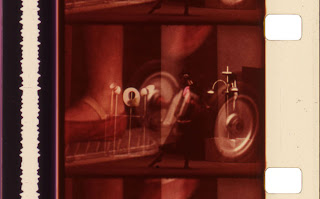Sidney Peterson's book: The Dark of the Screen
Sidney Peterson, one of my ten favorite film-makers, published a book in 1980 titled The Dark of the Screen. It starts with the following haiku by Shikisha Fumei (or so it says in the book, Peterson constantly makes up facts throughout, following his surrealistic urges):
At a single match
The darkness
Flinches
I really love the hilarious and imaginative title of the first chapter: "A Movie House is an enlarged camera Obscura for the sale of popcorn, a Darkroom for star-gazing right side up"
In the chapter titled "The Anxious Subject", Peterson also talks about how his idea of art was formed. Here are two paragraphs from there, written in his very idiosyncratic style. The emphases are mine.
'It happened so slowly, the dawning of the idea that film could be an art. One had the experience but not the idea. I vaguely recall an Oliver Twist in twelve reels (It had to be the Pathé 1909 version, if not the 1910 Vitagraph treatment, or, conceivably, the 1912 independent production with Nat C. Goodwin as Fagin) that was so grim it had to be something more than entertainment. When Birth of a Nation was being roadshown around the country, an uncle took me to see it in a theatre in Oakland, California, and it cost a dollar. I was impressed. The racism was water off the duck's back. I think it was the first time I had ever seen sheets used for anything but sleeping between or Halloween. A year later, at the Panama Pacific International Exposition, I saw Chaplin making something and the seeds of future improvisation were firmly planted. Rather later, I had a friend whose father, a Unitarian minister, was a friend of Vachel Lindsey, from whom we had caught a, to me incomprehensible, passion for movies as something more than they seemed to be. And then, in the early 'twenties, I remember being vaguely affected by Elie Faure's Art of Cineplastics in The Freeman (re-encountered more than a quarter century later in the San Francisco Museum of Art's Art in Cinema Symposium) with its vision of things to come;"what the art of the cinemimic may presume to become if, instead of permitting itself to be dragged by theatrical processes through a desolating sentimental fiction, it is able to concentrate itself on plastic processes, around a sensuous and passionate action in which we can all recognize our own personal virtues." I'm no longer sure that I know what he was talking about but at the time Faure was an enormously impressive figure. If he chose to pontificate about movies, who was I not to listen? It was a curious period. A lot of Americans were feeling the need for a little rhetorical hyping to compensate for the lack of excitement in their own aesthetic preperceptions. It was part of an alleged national coming of age and if Frenchman wanted to extend our illusions by envisaging an art of film that was not only "lively" but plastique, we were ready for it, whatever it might mean and however it might be understood by an art industry preoccupied with the need to straddle the gap between art and the imperatives of mass amusement, the need "to be dragged by theatrical processes through a desolating sentimental fiction."'
And a few paragraphs later:
'"In his mind unfolds the whole story." To which should be added the cry of Beaumont and Fletcher: "Plot me no plots!" Imagine a psychology based on the need for a narrative continuity as absolute as that of most film, in which a dénouement has the obligatory significance of a categorical imperative, becomes, in effect, the ground of knowledge, in which "how's your second act?" becomes a more important consideration than your family romance or lack of ego development. The idea is not unthinkable. It is implied in the ancient metaphor of the God-directed theatrum mundi and was explored by Burke in his Philosophy of Literary Form. I am not suggesting that babies be disposed of with their baths, merely that there are continuities and continuities and that the dash to unscramble the egg and put Humpty Dumpty together again should be contained. The Elizabethan sensibility did just that with its fusing of the arts of painting and poetry. Ut pictura poesis. In Shakespeare what emerged was the stage-clearance scene as his structural unit, with scenes symmetrically grouped around a central scene, as in a triptych. The influence of emblem books, "talking pictures," enabled him to present characters as in a series of snapshots rather than, as in film, in constant motion. Scenes were formally related by "mirroring" and other such emblematic devices. Whereby it became possible to emphasize the thematic material at the expense of a narrative continuity. The whole process is eloquently set forth by Mark Rose in his Shakespearean Design and I wish I could have seen it thirty years before he published it. I might have stumbled a little less in groping for a rational structure, conceiving of sequences as clumps of material with reflection repetitions and such, serving, at least formally, the purpose of the stage-clearance.'
For more info, here is Canyon Cinema's page for Sidney Peterson. The image is from Peterson's Clinic of Stumble, which I have not seen.

Comments